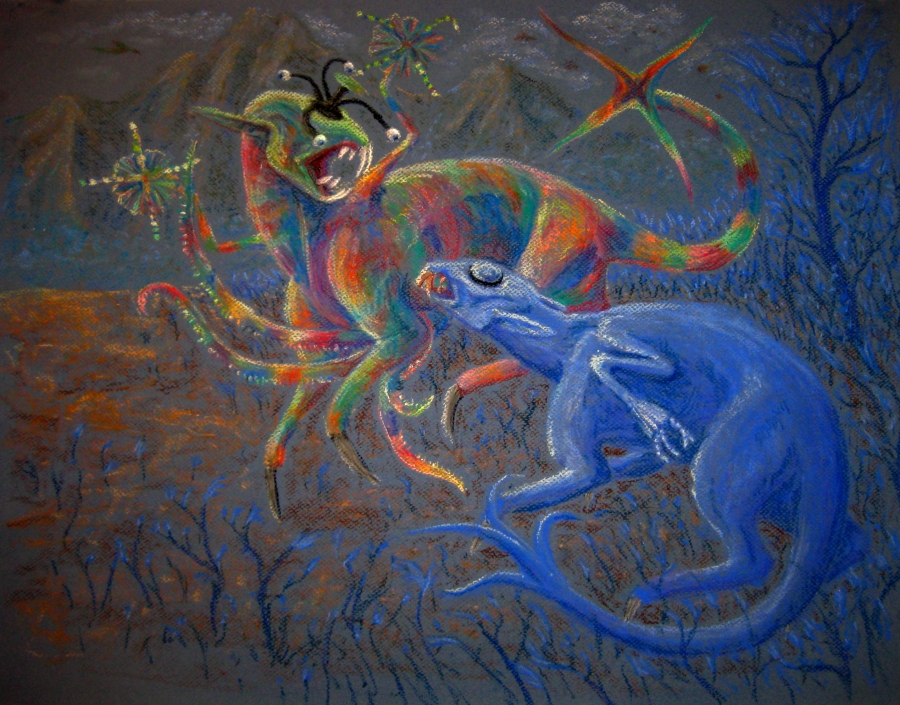ShopDreamUp AI ArtDreamUp
Deviation Actions
Description
Long-winded--and occasionally esoteric--explanations ahoy! Only the brave dare go on.
This is a photo of a pastel drawing I did for a spring 2009 art class. I'm inexperienced with pastels, and it shows. My color application was--compared to that of another student who's been working with pastels for much longer--far too light, and consequently the blue color of the paper is too prominent and makes all the other colors appear washed out. I held back partly because I saw how quickly a stick of pastel could be worn down by just a few broad strokes on the page. In other words, I was worried about using up the pastels by applying too much pressure to the page. I tried to bring out the colors digitally by changing the saturation, lightness and contrast. I also found that for some reason the composition looks slightly better when mirrored; the original illustration faces the other way. Of course, there's only so much that changing the color channels can do to fix a picture that would look better if I'd gotten it right the first time--and it certainly won't fix all the anatomical issues.
This illustration depicts two viscerapods (Viscerapoda circumoculus, common name currently undecided) of a species in the same genus as circaens (Viscerapoda pennatus), on their home planet which I also haven't picked a suitable name for. Viscerapoda translates to "intestine foot", referring to the prehensile tentacles all viscerapod species can protrude from an opening in their body cavity. Circumoculus means "circular eye." This may seem redundant, because eyes tend to be round. However, the name refers not to the shape of this species' eyeballs but to the shape of the single eyesocket at the top of its head, which is covered on the top by a thin circular eyecap that can be raised or lowered.
V. circumoculus is morphologically, physiologically, and behaviorally distinct from V. pennatus. I will just touch on a few of the differences, mainly those relevant to this picture. V. circumoculus is a quadruped (which still has a total of six skeletal limbs) and an herbivore. While circaens have dramatic sexual dimorphism, this species is hermaphroditic. Evolutionarily, it sacrificed its ancestor's insulating layer of feathers and gained an epidermis completely covered in color-changing chromatophores analogous to those of an octopus (in circaens, only a few parts of the anatomy, such as the tentacles, have chromatophores). They communicate emotions and ideas primarily through a complex and ever-shifting mosaic of colors and patterns on their skin. The chromatophores are also used for camouflage. In this interaction, both chromatophore uses are present. One viscerapod is making a threat display which involves appearing as large as possible, baring its chisel-shaped teeth, and displaying a rippling array of intense colors. The other individual is trying to diffuse tension by assuming a submissive posture and blending in with the coloration of the nearby vegetation.
This is a photo of a pastel drawing I did for a spring 2009 art class. I'm inexperienced with pastels, and it shows. My color application was--compared to that of another student who's been working with pastels for much longer--far too light, and consequently the blue color of the paper is too prominent and makes all the other colors appear washed out. I held back partly because I saw how quickly a stick of pastel could be worn down by just a few broad strokes on the page. In other words, I was worried about using up the pastels by applying too much pressure to the page. I tried to bring out the colors digitally by changing the saturation, lightness and contrast. I also found that for some reason the composition looks slightly better when mirrored; the original illustration faces the other way. Of course, there's only so much that changing the color channels can do to fix a picture that would look better if I'd gotten it right the first time--and it certainly won't fix all the anatomical issues.
This illustration depicts two viscerapods (Viscerapoda circumoculus, common name currently undecided) of a species in the same genus as circaens (Viscerapoda pennatus), on their home planet which I also haven't picked a suitable name for. Viscerapoda translates to "intestine foot", referring to the prehensile tentacles all viscerapod species can protrude from an opening in their body cavity. Circumoculus means "circular eye." This may seem redundant, because eyes tend to be round. However, the name refers not to the shape of this species' eyeballs but to the shape of the single eyesocket at the top of its head, which is covered on the top by a thin circular eyecap that can be raised or lowered.
V. circumoculus is morphologically, physiologically, and behaviorally distinct from V. pennatus. I will just touch on a few of the differences, mainly those relevant to this picture. V. circumoculus is a quadruped (which still has a total of six skeletal limbs) and an herbivore. While circaens have dramatic sexual dimorphism, this species is hermaphroditic. Evolutionarily, it sacrificed its ancestor's insulating layer of feathers and gained an epidermis completely covered in color-changing chromatophores analogous to those of an octopus (in circaens, only a few parts of the anatomy, such as the tentacles, have chromatophores). They communicate emotions and ideas primarily through a complex and ever-shifting mosaic of colors and patterns on their skin. The chromatophores are also used for camouflage. In this interaction, both chromatophore uses are present. One viscerapod is making a threat display which involves appearing as large as possible, baring its chisel-shaped teeth, and displaying a rippling array of intense colors. The other individual is trying to diffuse tension by assuming a submissive posture and blending in with the coloration of the nearby vegetation.
Image size
900x705px 539.6 KB
© 2009 - 2024 Scutigera
Comments11
Join the community to add your comment. Already a deviant? Log In
The eyecap is such a weird-looking, cool feature, I love the one with the eyes extended 




































